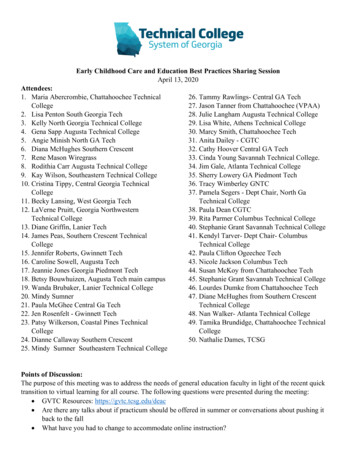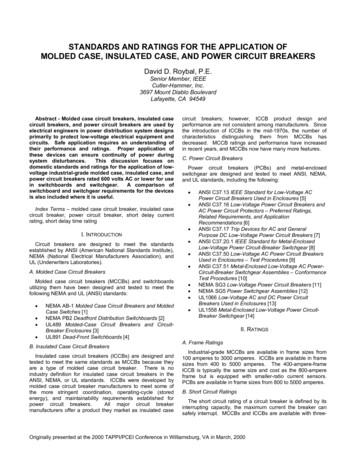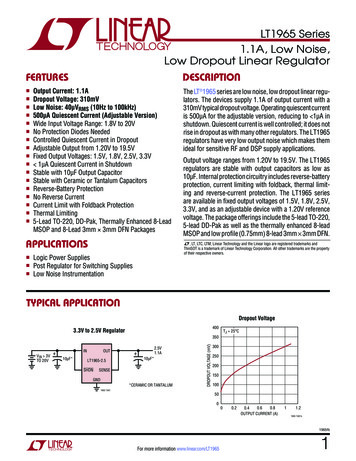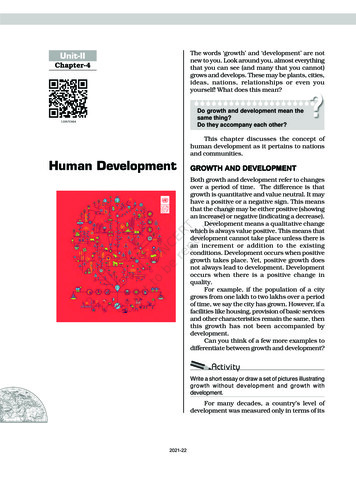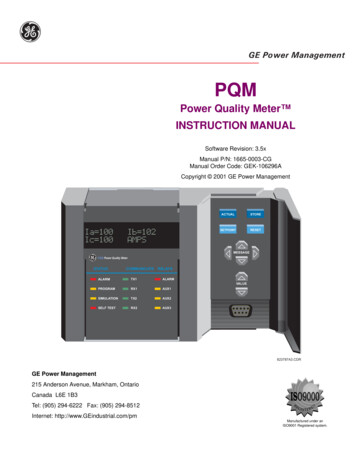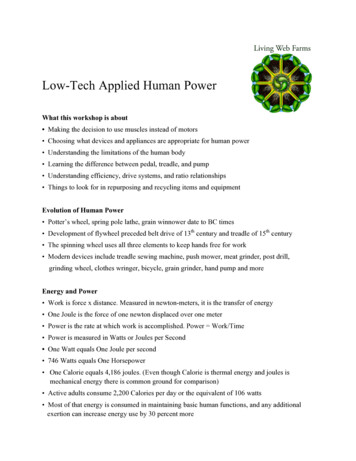
Transcription
Low-Tech Applied Human PowerWhat this workshop is about Making the decision to use muscles instead of motors Choosing what devices and appliances are appropriate for human power Understanding the limitations of the human body Learning the difference between pedal, treadle, and pump Understanding efficiency, drive systems, and ratio relationships Things to look for in repurposing and recycling items and equipmentEvolution of Human Power Potter’s wheel, spring pole lathe, grain winnower date to BC times Development of flywheel preceded belt drive of 13th century and treadle of 15th century The spinning wheel uses all three elements to keep hands free for work Modern devices include treadle sewing machine, push mower, meat grinder, post drill,grinding wheel, clothes wringer, bicycle, grain grinder, hand pump and moreEnergy and Power Work is force x distance. Measured in newton-meters, it is the transfer of energy One Joule is the force of one newton displaced over one meter Power is the rate at which work is accomplished. Power Work/Time Power is measured in Watts or Joules per Second One Watt equals One Joule per second 746 Watts equals One Horsepower One Calorie equals 4,186 joules. (Even though Calorie is thermal energy and joules ismechanical energy there is common ground for comparison) Active adults consume 2,200 Calories per day or the equivalent of 106 watts Most of that energy is consumed in maintaining basic human functions, and any additionalexertion can increase energy use by 30 percent more
The human body is only about 25 percent efficient in its ability to convert chemical energyinto workOptimizing Human Power Potential Muscles in motion encourage the intake of oxygen and aerobic respiration which is thesource of long-term energy; maintain a brisk rate Pay attention to your pace. A rate of 50 to 70 rpm is the optimal for pedal powered drives Leg power is best for tools requiring higher power inputs Determine the ideal position and distance between pedals/treadles and feetDrive Systems The goal is to optimize efficiency and minimize losses through slippage and friction Direct drive is efficient but inflexible to conditions Chain drive is nearly as efficient and allows for ratio adjustments and changes. Efficiencyincreases with clean chain, tight fit to sprocket, and perfect alignment. Sprocket-chaincompatibility means matching tooth size with chain width (3/32” or 1/8”) and pitch (1/2”) Belt drives are inexpensive and uncomplicated. V-belts and flat belts are most common, and awheel with the tire removed can serve as a large drive pulley using a flat belt. A V-belt is lessprone to slippage when the proper pulleys are used Friction drives are extremely simple and provide a quiet, convenient reduction for high-speeddevices. Drawbacks include low efficiency and axle shaft wear. Best used with low-powerdevicesFlywheels Flywheels store kinetic (motion) energy and return it to the system when needed. The heavierand faster store more energy. Flywheels tend to even out irregular torque input produced by crank position (see illustrationbelow) Flywheels take additional energy to get up to speed but can be maintained with reduced effortthereafter
Crank position as it affects power outputReduction Ratios and Compound Drives Gear sets or combinations are used to determine the speed, direction, and force of mechanicalaction. This applies to chain and pulley drives as well The Ratio is the difference in size between two interacting gears (or sprockets, chainrings, orpulleys). To determine ratio, divide the size of the driven gear by the size of the driver gear.Example: 12-inch driven gear mated to 3-inch driver gear yields a 3:1 ratio; the driver willrotate three times for every one rotation of the driven gear Power vs. speed: A 3:1 ratio reduces the effort needed to accomplish the task but it happens ata slower rate. A 1:3 ratio speeds up the rate but requires more input effort to accomplish Compound drives are used to increase gear ratios when there are limitations on the size ofavailable sprockets. Bicycle sprockets are usually limited to 10 or 11 teeth (about 1.6 inches)
Compound pulleysAppropriate technology brick-making device employing flywheel and compound gearingFrames and Stays It is easier and cheaper to repurpose existing bicycle frames or stationary bikes than to startfrom scratch. Some bike trainers may also have existing or modifiable flywheels Fit the frame to the intended purpose. A repurposed sewing machine treadle may work forlow-power appliances but you’ll need a sturdy bike frame for pumps and high-speed needs Sturdy mounting and stability are essential for tasks requiring more effort. Extending the legsor mounting the unit on a platform may be necessary Plan ahead for ergodynamics. Make sure the seat height and handlebar position are practicaland comfortable for extended use. Seats and handlebars are easy to replace, but basicdimensions not so much Be prepared to cut and modify existing bicycle frames, and substitute non-cycle componentssuch as steel pipe and angle iron if needed. Welding skills are well worth developing, but you
can still accomplish a lot with U-bolts, straps, steel plate, and clamps. Don’t be afraid to beselective when looking for used bikes and frame sizes and styles. There is a whole universe ofused and discarded bicycles out there and they are relatively inexpensive or even free for theaskingBasic bicycle anatomyWeights and Power Potential of AnimalsAnimalWeight (Lbs.)HorsepowerOxen.75Horse1.00Cow.45Mule770 to 1,000.70Donkey440 to 660.35Human130 to 200.10THPH
Human Power Output for Various spiration.1 to 1Hand-crank(single-arm)110 to 140Hand-crank40 to 45Hand-crank10 to 30Pedal400 to 500Pedal300 to 400Pedal225 to 300Pedal75From The HumanPowered HomePower Consumption of Typical Household AppliancesApplianceAlarm clockElectric toothbrushLaptop computerPrinterFanStereoSewing machineColor TV (CRT)Power Used (Watts)
Color TV (plasma)BlenderWashing machineVacuum cleaner1,000 to 2,000Table saw1,200 to 2,000ResourcesThe Human-Powered Home by Tamara Dean; New Society Publishers; ISBN: 978-0-86571601-8Probably the most complete reference book available for the down-to-earth application of humanpower for operating tools, kitchen appliances, and many other everyday devices. Includes photos,illustrations, and clear explanations of the mechanical requirements needed to convert or buildyour own equipmentLow-Tech Magazine l-poweredmachines.htmlA good resource variety for building your own pedal-powered machines, with links to free plansand other resourcesInstructables ler/The Full Belly Project is a non-profit whose objective is to aid in food production for developingcountries by providing simple and easily accessible technology. The link above is for a UniversalNut Sheller. The link here https://www.youtube.com/watch?v bCIzeMzNmyM describes a footpowered rocker pumpTable of Radius Values for Bicycle e/chain length/sprocket radius table.htmlMark Dempsey’s Pedal Lathehttps://www.youtube.com/watch?v OFsoE5hlvG4
Potter’s wheel, spring pole lathe, grain winnower date to BC times Development of flywheel preceded belt drive of 13th century and treadle of 15th century The spinning wheel uses all three elements to keep hands free for work Modern devices include trea

